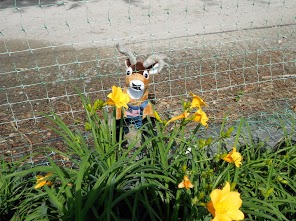
by Julie McConnell | Jul 27, 2015

Deer are known to eat daylilies in the landscape. To prevent browsing, choose other plants or create a barrier with deer fencing.
Any seasoned gardener knows that even a well maintained garden will eventually face a pest issue. Pests come in all shapes and sizes and may include weeds, disease, insects, moles, rabbits, birds, and deer. Although some gardeners may invite wildlife into their gardens when that adorable deer eats your prized hydrangea it tends to lose the cuteness factor.
Regardless of what type of pest issue you are facing, the only way to establish a successful control program is to correctly identify and understand some basic things about the pest. Incorrect assumptions or misidentification can lead to taking the wrong action and may even cause more harm to plants.
Some things to know about your pest (after identification):
- Preferred host or target plant – diversify landscapes to minimize susceptibility to each pest.
- Feeding/damage caused – is it just aesthetic or will it cause long-term harm?
- For rapidly reproducing pests such as insects or fungi, what is the timing of new generations? For example, if you eliminate adult insects expect that eggs are waiting to hatch – you need to know when to retreat.
- What natural enemies might help reduce populations and how can they be preserved?
- Be sure to match control methods with pest behavior and activity. For example, if you want to use an insecticidal soap on azalea lace but you need to know that they feed from the underside of the leaf in order to properly coat them with the product.
Take the time to get to know the pest in your backyard and management efforts will be much more effective. For help with identification and control, contact your local extension office.
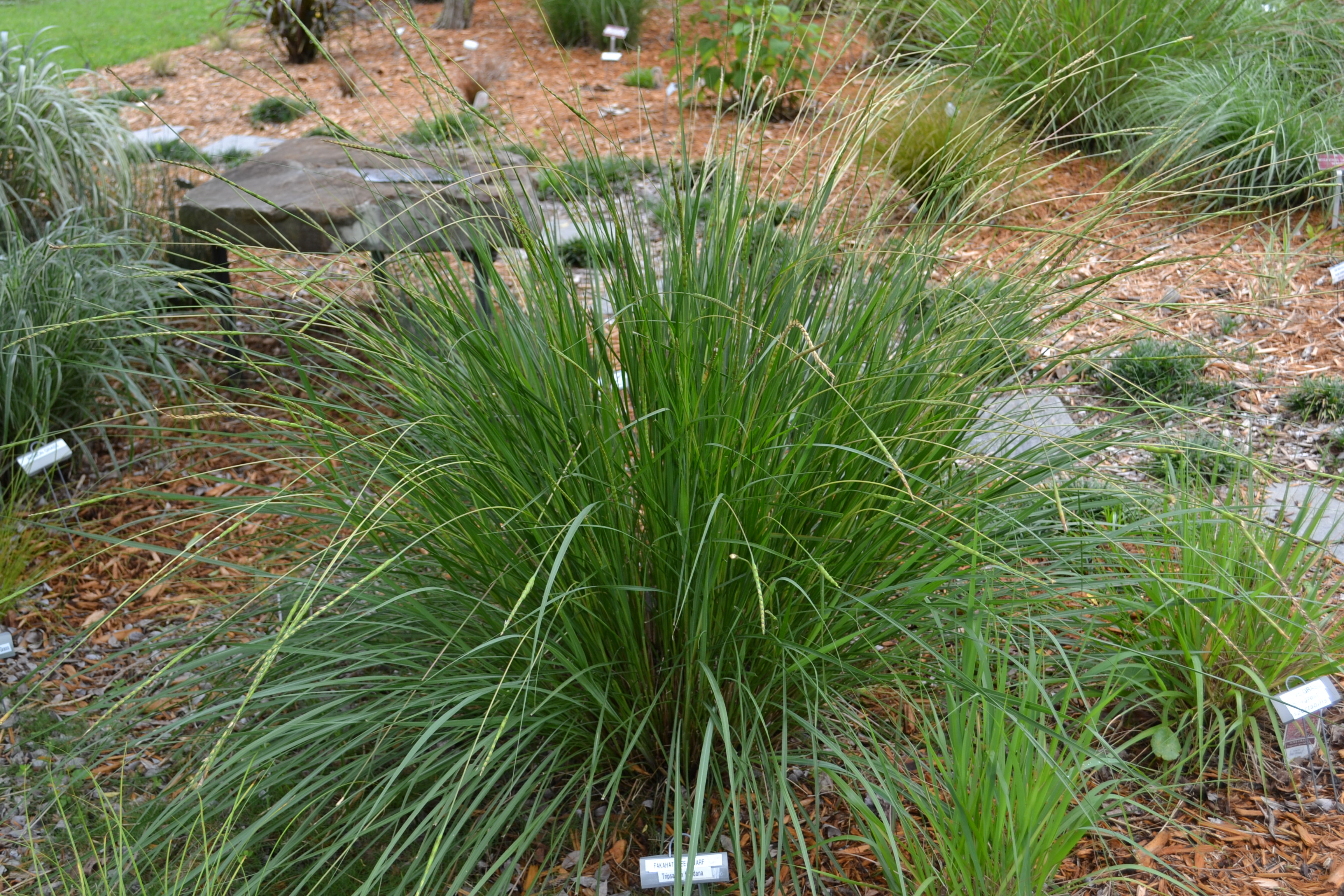
by Beth Bolles | Jul 20, 2015
Native plants can more readily be found in local nurseries to enhance landscape plantings. Not all natives are suited to every habit so it is still important to match the plant’s requirements with a suitable area in the landscape.
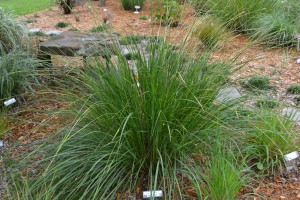
One low maintenance native that is more suited to a specific area is the landscape is the Gamma or Fakahatchee grass (Tripsacum dactyloides and T. floridana). This clumping perennial grass grows best in moist or even boggy soils. It has attractive green foliage and upright flower stems that appear in mid summer. Although the flowers are not very significant, they do have a red color when viewed up close.
The Eastern gamma grass can grow five feet in height so many gardeners prefer the dwarf version that reaches about 2-3 feet in height. Plant in areas of full sun or partial shade as a specimen plant or use in a mass of three or five.
In areas that receive colder temperatures, gamma grass can add fall interest to the garden. Leaves will change to a shade of red with first frost and plants can die back to the ground during freezing winters. New growth returns in the spring. Basic maintenance includes pruning back in the spring.

by Mary Salinas | Jul 20, 2015
July always brings the blessing of abundant figs on my trees. A new crop waits to be picked and enjoyed every day for nearly a month. The tender sweet fruit can be enjoyed fresh, prepared into jams or used in a myriad of recipes.
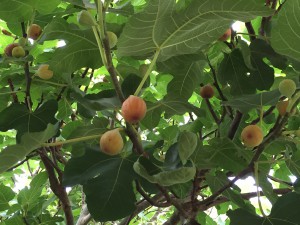
Ripe figs ready to pick. Photo credit: Mary Derrick, UF/IFAS Extension.
The fig (Ficus carica) is native to Asia Minor and the Mediterranean regions of the world and has been cultivated for an estimated 7,000 years. Spanish explorers brought the fig with them to Florida in 1575 and it has had a presence here ever since. Since the fig is adapted to a dry climate in its native regions, the humidity it encountered in Florida can cause fruit to split; but new cultivars have been developed to minimize this problem.
Fig trees usually grow to a maximum of 25 feet and have large bright green leaves that fall in the autumn. Fruit develops from June to August, depending on the chosen cultivar.
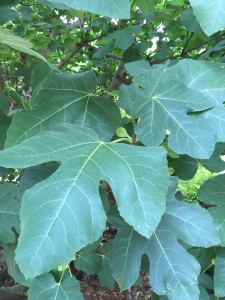
The large fig leaves are quite ornamental. Photo credit: Mary Derrick, UF/IFAS Extension.
Choose a spot for planting a fig tree that receives full sun and good drainage. Once established, figs are drought tolerant and only need supplemental irrigation if we have an extended drought. No structural pruning is required but you can prune to keep the tree from growing so tall that you cannot pick the delicious fruit. Be sure to do your pruning just after the fruit is gone as the fruit develops on the terminal ends of the branches from last year’s growth.
Many figs grow and fruit sufficiently without applied fertilizer, however, a light fertilization with a 10-10-10 with micronutrients can be helpful for small trees getting established and those with reduced fruiting. Young trees can benefit from a ½ pound three to five times from February to August while large trees could use up to 4 pounds per application on the same schedule.
There are a few pests that do damage figs; the most common, though, are the birds and squirrels that get the fruit before you do. Seldom do figs need to be sprayed when grown in the home garden.
For more information:
The Fig
Fig nutrition facts and recipes

by Les Harrison | Jul 15, 2015

Native yuccas fit easily into the landscape without breaking the bank or the back of the gardener.
Being sharp is usually considered a complement. It implies the recipient of this assessment has the intellectual ability and the mental acuity to handle with ease the rigors of contemporary life.
In north Florida’s native plant world the yucca genus was sharp long before people employed it in landscapes. It also has the sharp pointy spines to enforce its tactics.
Local yuccas are perennial shrubs which can grow into small trees with a unique shape. There are approximately 50 species in this genus worldwide on every continent except Antarctica.
Their most obvious and notable feature which makes them easy to identify is their leaves. These are elongated in thick clusters around the stems.
The sword-like shape is tipped with a hardened point which can quickly get the attention of anyone passing too close. The bristly structure of these evergreen plants gives them an intimidating appearance which most animals and people avoid.
The annual blooms appear at the top of these plants and protrude above the greenery. Honeybees and other pollinators will visit the profusely fragrant bell-shaped flowers to collect nectar and pollen.
In their native range, these plants are seen in sites where there is high exposure to the sun. They will not grow in heavy shade, and languish with little change if there is less than six to eight hours of daily sun.
Sandy well drained soils are the most likely locations where yuccas will prosper and grow. Their nutrient requirement are low, so they rarely display symptoms of a nutrient deficiency.
Likewise, their need for water is paltry. Once established they will easily withstand droughts and extended dry periods.
The common species native to north Florida in this genus are Adam’s needles (Yucca filamentosa) and Spanish bayonets (Yucca aloifolia). These plants are similar in appearance, but each has distinctive traits.
Adam’s needles are the smaller and shorter of the two species. The multiple stems may reach three feet in height, but extend to over six feet when the cream color blooms appear in early summer.
The green leaves are pliable with white threads of fiber trailing from each. There is a variegated cultivar which is popular for landscaping projects.
Spanish bayonets produce multiple trunks per plant and may grow to over 15 feet. They produce rigid dark green leaves projecting from the thick trunks and will impale any trespasser.
White blossoms appear in the center of the plant above the foliage from spring to late summer depending on several weather related factors. These yuccas have a high salt tolerance making wild plantings common to coastal areas.
Disease and insect problems are few for these hardy plants. Too much water resulting in excessively wet roots and extreme cold are the biggest problems.
For the sharp homeowner these native plants make a pointedly good addition to the landscape.
To learn more about native yuccas in north Florida, contact the nearest UF/IFAS Extension office.

by Matthew Orwat | Jul 15, 2015

Coneflower, after deadheading, with new growth and flowers. Photo Credit Matthew Orwat, UF/IFAS Extension
During these “dog days”, full of hot temperatures punctuated with intermittent rain, gardeners can lose the motivation to get out there and get things done. One task, deadheading, can make a huge difference in the appearance of one’s landscape without a whole lot of effort.
The act of deadheading is the removal of individual blooms or flowering stalks that are past their prime. When deadheading, always trim the stem to an area above a node. The node can be determined by the presence of a leaf and its attachment to a stem. This area is known as the leaf axle.
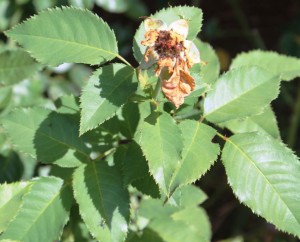
Roses before and after deadheading Photo Credit Matthew Orwat, UF/IFAS Extension

Roses before and after deadheading Photo Credit Matthew Orwat, UF/IFAS Extension
The main benefit of deadheading flowering shrubs and perennials, particularly in the spring and summer, is that removal of spent flowers promotes new growth and more flowers. It also eliminates unsightly seed stalks and decaying petals from the landscape. If trying to save seed or promote re-seeding, do not deadhead in the fall or near the terminal side of a given season for any plant.
Once proper deadheading is performed, new growth will emerge from the trimmed area. Oftentimes, this new growth is another single flower or flower cluster.
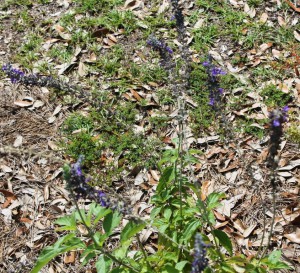
Salvia, before and after deadheading Photo Credit Matthew Orwat, UF/IFAS Extension
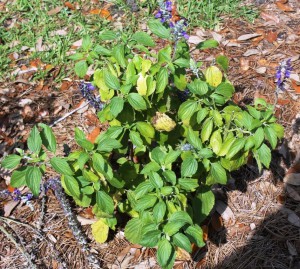
While this process is generally used for repeat flowering shrubs, such as roses, it can also be used effectively on crapemyrtle, salvia, cone flower, coreopsis, and many others.
Promote an extended bloom season in the garden and deadhead!













